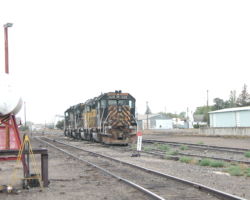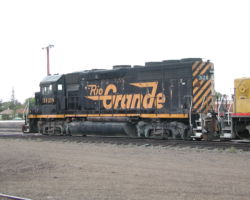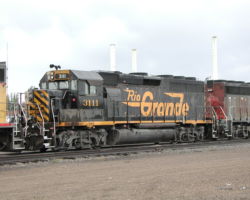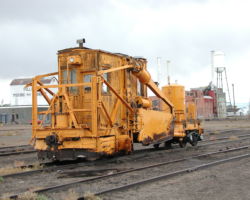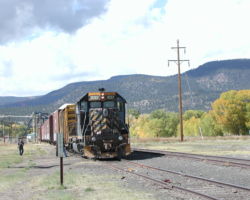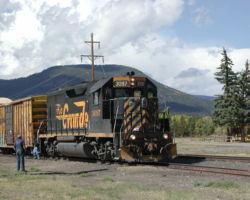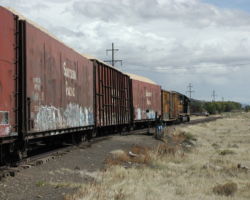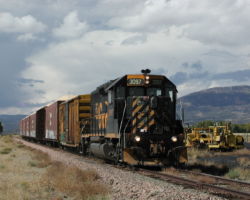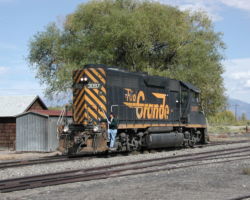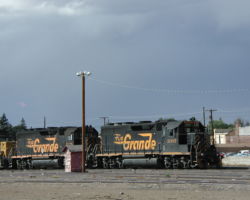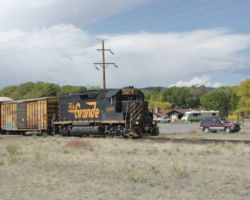As some of you know, I’m sure, I’m an engineer with FedEx when I’m not out railfanning, but for the last week I’d been really dragging quite a bit – finally, at the slight prodding of Michelle, I decided that it was time to take a day off. After all, it had been a reasonably slow week, and I really didn’t have anything pressing to get done. So, I decided to make Friday into a complete part of this nutritious three day weekend. Okay, I’m tired, bad humor like this is going to keep showing up. That’s not a threat, it’s a promise.
So, Friday morning at about 6:30 I rolled out of bed to go see what my options were if I wanted to go find some Grandes. In case you didn’t notice it on the front page, I have this handy little tool that Michael was nice enough to build called the DRGW Locotracer. It not only tells me the latest trace data on all surviving D&RGW locomotives, but is also good enough to query RailARC to find out which ones we have and have not gotten yet. It’s become an essential tool for precision railfanning… 🙂
Originally I had planned on heading towards Denver and the Moffat line, to pursue a wandering DRGW SD50 (5502) that had come in from the north the night before, and then work west to Bond, where 5409 was performing local work. However, a quick look at the trace for Friday morning revealed that a trio of D&RGW GP40s had left Pueblo only a few hours before, and better yet, they were all virtually unknown on RailARC. While this trio travelling to Alamosa is nothing unusual, the fact that it happens when I can catch it is novel. So, I packed up all of the railfanning gear into the truck and headed south towards Walsenburg on I-25.
Of course, considering that the run to Pueblo is entirely along the Joint Line (though until you get south of about Fountain, you really have to know where to look through the trees and buildings for it), I did see my share of trains on the way down. Being it was still semi-dark and intermittantly raining, I decided to forget about photographing any of these. The only thing of note was an empty BNSF coal train headed north with all standard rotary dump aluminum cars except for two of the Trough Train segments stuck on the back. I don’t have a good reason for this one – I always thought that the Trough Train travelled together, except for the one spare car that sits wherever…
The rest of the trip to Alamosa was through alternating cycles of wind, rain, and bright sunlight. Upon arriving in town, I found a large chunk of power sitting in the yard, consisting of DRGW3128 & 3111, UP 5310, and SP7959 (see photo #1). I poked around a little more, and after concluding that the missing Grande (DRGW3097) was nowhere to be found, I called Michelle back in the Springs to have her verify 3097’s arrival in Alamosa. Sure enough, it posted with the rest of the units at around 8am. That meant it had to have gone out on one of the two lines coming off Alamosa – either towards South Fork or towards Antonito. Not yet wanting to contemplate which line to follow, I continued photographing the equipment in front of me, including an interesting little yellow spreader (photo #4). I also spent a few minutes contemplating one grade crossing that still had dual-gauge track embedded in it, wondering how long that had been there and thinking about the great fun of watching narrow gauge trains working over all these lines I never associate three-footers with, like the Joint Line up to Denver. Those would have been the days – too bad I wasn’t even born before D&RGW narrow gauge disappeared from the scene.
At this point, I was a little befuddled. Pick the wrong route, and being as the unit had already had three hours to work at this point, I’d probably miss seeing any action at all. Or, I’d get a different unit, and the Grande would have taken the other line. So, after careful inspection of the turnout alignment in the yard, the looks of the rails on both branches (which were both rather shiny), I concluded I should go west further out on the Alamosa Subdivision. Okay, while I did check all of the above, the real deciding factor was that there was sunlight out west towards South Fork, and it was raining to the south (along the Antonito line). I figured that even if I chose incorrectly, this way I’d be back from the western San Luis Valley about the time the sunlight started to fall on the Antonito line, so I really couldn’t lose. Besides, call it a gut feeling, and I’ve learned not to ignore those.
I drove and drove, and at noon was within ten miles of the end of the line. While the rails still looked a bit shiny, it was getting harder to tell, and the condition of the line was fairly degraded. I actually found myself wondering if trains even made it out this far anymore after noticing some unevenness between the rails and just the general amount of overgrowth in Del Norte. As I crested a hill just a little further down the line, I looked down the line and seeing nothing contemplated turning around. When I pulled off in a driveway to get turned around, however, the scanner crackled to life and it was the voices of a crew switching cars (covered in static, of course…). Well, okay, something’s close, so I decided to press on towards the end of the line and South Fork, CO.
So here I am, ten miles or so from the end of the line (at a place called Hanna, according to my trusty Altamont Press timetable. I don’t usually plug products, but these are truly excellent little pocket guides to lines you don’t know and don’t have time to research extensively. If you don’t have a set, I highly recommend you order some.) My scanner just crackled to life, but because it’s just the crew talking amoungst themselves, I don’t get a unit number. I figure it’s only 10 more minutes, so I pull back on the road and continue west to check it out.
Upon arriving in South Fork, I’m pleasantly surprised to see DRGW3097 switching wood chip cars for a local plant. I immediately slide the truck into a parking space out in front of a cafe and immediately behind where the crew is switching. They seem friendly, yet they’re busy professionals, so I just stay out of their way and take some shots of 3097 going back and forth moving cars around. I would really like to know a few things about operations in the valley, but it’s not worth being a nuisance. Soon, everything’s coupled up (photo #5) and they’re pumping up the brakes preparing to leave and head back towards the Alamosa yard. There’s also a storm approaching from the west, bring dark skies and doing strange things with the light, so I’m glad that everything’s ready for the return trip this quickly. (photos #6 & 7) Look at that lightweight jointed rail bending under the weight of the train… Sheesh – still pretty cool to watch, though.
One thing I’ve always wondered is how they keep those woodchips in the cars – I see them moving along the Joint Line sometimes, and can never figure out how those big piles of light chips stay in place. If anyone has an answer, I’d like to know…
I head back to a crossing just outside of town, confuse a few people by suddenly pulling off a side road into the grassy shoulder. After answering the usual question from a helpful local with “No, I’m not lost, I’m just a photographer,” I headed across the track to set up the shot. It’s only at that point that I noticed two other railfans had already taken up spots and I spent a few minutes working out shooting positions so we’d all be happy. The unfortunate thing about railfanning this line is that it’s hard to avoid using the standard “grade crossing wedgy” shot over and over, as it’s all perfectly flat with very few bridges. Also, the clouds were getting close enough to cast annoying shadows, so I wound up missing the shot I really wanted.
Figuring that the local has a speed limit of 25mph and I hadn’t had lunch, I stopped at a convenience store on the way out of town to grab a bite to eat. Once I finally got through the long line and back outside, I was pleased to say I could still see the last car down the track. So once again I drove ahead of it, and met up again at Hanna (photo #8). By this time, the storm behind us was getting considerably closer and blacker, and a few minutes after the train had passed the beautiful warm sunlight faded into a cold shadow. While 3097 and train forged ahead, I spent close to 15 minutes fighting with my laptop, getting it to boot correctly so I could offload all of the morning’s photos. While waiting, I vaguely recalled seeing a train here years ago (late 1980s or early 1990s) while on vacation with my parents. Of course at the time I was too young to really have an appreciation for the last days of the Grande, but it was probably the collection of these black and golden memories that made me into the D&RGW nut I am today.
While I probably could have finished this in two segments, there are still several good and interesting photos that I’d like to share, so I’m going to drag it out into three parts… So once I finally got the computer to cooperate with me, I headed back out on the road. Unfortunately, that fifteen minutes had given the local quite a lead, and it wasn’t until halfway to Monte Vista that I finally caught up with the train again. Remembering the almost street running in Monte Vista from a trip the year before, I decided to make this my next stop. It turned out to be quite a wait, but very rewarding and an interesting shot (photo #9).
I stopped at the junction with the San Luis Central to catch a few more photos, and then headed back to Alamosa. With the considerable lead I had, I took my time finding a decent shot, as it would probably be my last one of the day of this local. As it turns out, the curve immediately to the west of the road to Antonito provides an interesting shot (at least more interesting than a standard roster wedgy), especially from low angles.
The local proceeded out to the yard east of town, dropped his load off, and brought the engine back in light (photo #10). Again, the storm was creeping up on me, and a few minutes after snapping a pic of the now two leading Grandes basking in the afternoon sun (photo #11), the light faded and rain began to fall again. All in all, a very productive day.
On the way back, I stopped at Blanca to check out an abandoned branch headed south, as well as three MOW cars parked there. Concerning the branch, there’s not much left – the wye is still in place off the Alamosa line, and there are still rails buried in the sand, but they’re a long way from usable. The three of the MOW cars I found to be much more interesting. All three are D&RGW cars, one an old boxcar still with friction trucks – a very interesting sight in the twenty-first century! Perhaps there are roller bearings hiding in the journal boxes, I just don’t know… But, as such an odd beast, I felt a need to take a picture of it and its two kin. (photo #12)
Unfortunately, that really was the end of the railfanning for the day. I met a Loram grinder train at Walsenburg (RG318, if you care), but it was getting dark and I’ve seen it before, so I passed on it and headed for home on I-25.
The final shot for this trip is one of 3097 and my Blazer, just because I wanted to include it. Gee, the truck sure looks small next to that thing (and of course the difference in depth between the two objects didn’t help that, either…)
This work is copyright 2024 by Nathan D. Holmes, but all text and images are licensed and reusable under a Creative Commons Attribution-NonCommercial-ShareAlike license. Basically you’re welcome to use any of this as long as it’s not for commercial purposes, you credit me as the source, and you share any derivative works under the same license. I’d encourage others to consider similar licenses for their works.
